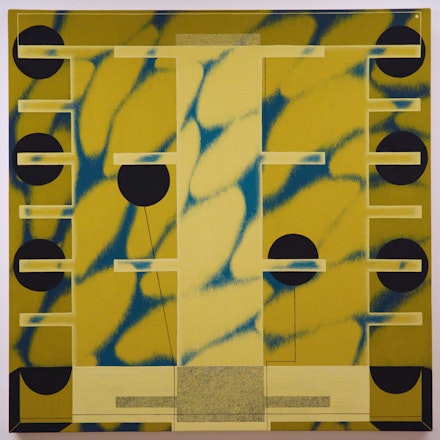Angela Heisch’s solo show at 106 Green Gallery in Greenpoint is her first in New York, and, having been acquainted with her paintings for some time, I was eager for this opportunity to reflect upon them. My hope was to pinpoint a vague affinity for her work that, thus far, I have only been able to characterize in mystified, psychological terms: My essential impression that Heisch’s paintings resemble a physical realm I have occupied in unconscious dreams.
The thirteen paintings in Resting Position, all completed in 2018, range from 16 to 36 inches square, a modest scale that invites contemplation rather than immersion. They are done in acryla-gouache on stretched muslin, and the finely granular quality of the gouache over the tight weave of the muslin gives them surfaces like smooth stones. In the most general sense, they are compositions involving geometry and pattern, and their dominant characteristic is their dense structural complexity. The symmetrical, interlocking elements comprising these paintings could be said to resemble architectural or mechanical systems, or cellular structures. In Fleshing Out, which is painted in warm, dry shades of brown, beveled right-angles evoke the legs and mantel of a fireplace, an impression enhanced by the pattern of flame-like, billowing swoops kindled behind it. One of the largest paintings, titled Back Bone, features mirrored sequences of archways running down the sides of the canvas that could be compared to both a classical colonnade and the narrow, regularly placed bones of a rib cage.
However, it is insufficient to describe these works in terms of the things they resemble, for their effect is not based on the invocation of forms. A physical vocabulary is instead required to describe them—hard and soft, liquid and solid, plastic and rigid—these are the dialectics at play in the paintings. They conjure the qualities of water and stone, glass and clay, often with ambiguity. Collapsed Air, a small blue panel whose very title speaks to an elemental sensibility, impresses me with a sensation of fluid water beneath molded ice; or if it does depict air, it is air caught within a petrified, stabilized atmosphere. Another painting, this one deep red and black, evokes a rudimentary diagram of pipelines disappearing into round, black boreholes. These same flat, velvet-black holes appear in many of the paintings, and impart a sense of depth that isn’t spatial. They are like mine shafts, tunneling not into deep space but deep into matter.

The aesthetic sensibility I attribute to Heisch’s work is rooted in the “material imagination,” which Gaston Bachelard describes in “Imagination and Matter” (1942).[1] Written in the decades prior to his better-known work The Poetics of Space (1957), these volumes propose that the fundamental images of the human imagination are not forms, but the primal materials of fire, water, earth, and air. Heisch’s paintings activate this sort of imagination, as matter dissociates from form within them. The exhibition title, Resting Position, evokes the posture of sleep or reverie, and fittingly, a characterization of the works on view could be borrowed directly from Bachelard’s description of the aesthetic territory of dreams: “The oneiric landscape is not a frame that is filled up with impressions; it is a pervading substance.”
In the exhibition statement, the artist describes the paintings she aspires to create as “intentionally ordered and uncooperative, as well as inviting, visually sound, and thin-skinned.” Pondering the “skins” of Heisch’s square panels, I think of Minecraft, the ingenious and hugely popular 2009 video game in which players craft dream worlds from cubes of rarified matter—blocks of stone, water, lava, metal ores, and wood—which are extracted from a procedurally-generated landscape. Material imagination also animates the Minecraft cubes, which are merely thin digital skins (surface textures placed over polygonal wireframes), but ones imaginatively filled with substances, so that it feels like an act of magic to make a “solid” block of stone or lava float across the ground. The cubes signify matter while also eluding its typical formal properties. Minecraft is an oneiric experience, relying on the sort of physics only possible in dreams, where gravity and substance are flexible: sometimes we experience dream-gravity as a gut-wrenching fall from great heights toward earth so believably solid that we are jolted from sleep in fear of the impact, while at other times (in the most delightful of dreams) we can fly, carried upon unyielding layers of air.
Heisch’s paintings are “thin-skinned” like the cubes in Minecraft; they are thin like the veil of a dream, beyond which we may encounter a world pervaded by uncooperative, unstable substances, one populated by images of material without form.
Notes
- Gaston Bachelard, “Imagination and Matter,” Water and Dreams: An Essay on the Imagination of Matter, Dallas: The Dallas Institute of Humanities and Culture, 1999 (3rd Printing), page 1. <https://mycourses.aalto.fi/pluginfile.php/204380/mod_resource/content/1/gaston-bachelard-water-and-dreams-an-essay-on-the-imagination-of-matter-1.pdf>

